9 Practical Ways to Start Creating a Montessori Home Learning Environment Today
Setting up Montessori inspired spaces in your home is easier than you might think!
In just 9 practical ways, this post will tell you how to do it today! And you can do it without spending a lot of money, if any at all! You can most likely use what you already have.
Even if you are still learning about the Montessori Method, setting up a Montessori Learning environment now is very doable. It will allow you to practice Montessori philosophies as you go along.
This is truly how teachers learn to lead and guide……….. by practicing in real time.
Start Here!
01. Declutter
Clean up all the clutter in the areas that you want to set up as Montessori friendly areas for your child. One of the biggest things we can do to follow the Montessori Method is to create order in our environment. Children thrive in order. Cleaning up and organizing their spaces is the first step to prepare them for their work.
02. Use Hooks
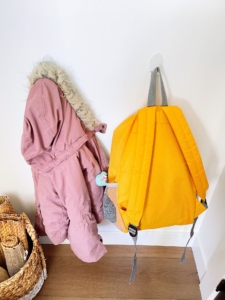
Hang command hooks in your child’s spaces to help create order. Hang the hooks at their eye level to make it easy for them to access. Here are some suggestions.
- The Kitchen: a place where they can hang an apron or a child sized broom, mop or dustpan
- Your Child’s Bedroom: a place for them to hang their clothes, a sweater, a hat etc.
- The Entryway or Mudroom: a place for your child to hang clothes that they need for going outside. Depending on the weather, a jacket, mittens, raincoat, hat, etc.
- The Bathroom: a place to hang a hand towel
- Outside Play Space: a place to hang shovels, rakes or buckets
03. Hang Realistic Art
You can find pictures of animals and real art on the internet. Print it on cardstock and laminate if you can.
Choose photos of things that are interesting to your child. Do they like tractors? Are they interested in pets? Hang pictures at their eye level. You can use a inexpensive $tree frame or just use masking tape on the back. Either works and looks great!
04. Prepare a Space for Shelf Work and Toys
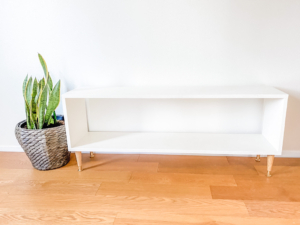
This can be in the living room, playroom or bedroom. Clear space on a lower shelf to organize your child’s toys and work. You don’t need to buy a child sized shelf if you don’t want to, you can use what you have. Make sure the area is easily accessible to your child. The space will need to have room to house trays and baskets for their work. If you don’t have a shelf for this, get creative. Use a coffee table or set up a small area in the corner of the room. Just create a place where your child can have a few toys and books.
05. Prepare a Kitchen Space
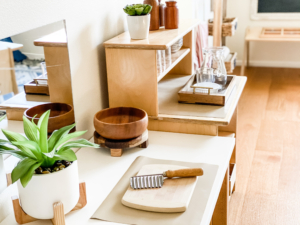
No need to have a fancy child sized functional kitchen, you can use what you already have. Clean out a large bottom drawer or cupboard to house your child’s kitchen items. Place things like child sized plates, cups, utensils, bowls, pouring pitcher, cleaning towels, child sized spray bottle etc. Or if you have a low bookcase you aren’t using that would work as well. I’ve had the same small shelving unit for over 25 years that I use in the Studio to keep our kitchen supplies. Get creative!
06. Gather Trays or Baskets
Use these to house work for shelves. You can use anything for a tray. Lightweight and sturdy trays or baskets will work best. They should fit the work or toys you want to place on it. It needs to be comfortably carried by your child independently. We have seen people use plastic dinner plates, small baking sheets or plastic containers. If you want to look for some really inexpensive trays, try $tree or the $ section in Walmart and Target. Having a place to store each individual activity will create a more organized space. You can find some we love at Amazon here.
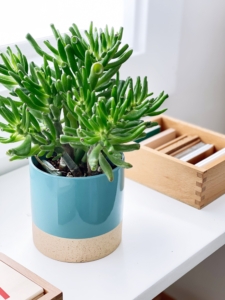
07. Add Some Plants
Choose a few hardy plants for your child to care for. Provide a little spray bottle or mini watering can that fits your child’s hand well. Help your child use this to care for a few plants in your home environment daily.
08. Consider Adding Music to your Day
You can just listen to good music as you and your child work through your day or you can schedule a time to sit and listen to music and talk about what they hear. Listening to different kinds of music leads to great conversation and creates interest. Explore any genre of music and begin to naturally create interest in different kinds of music.
09. Create a Story or Quiet Area
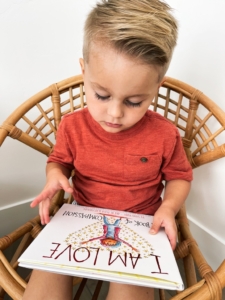
This would be a place where your child can find books that are more realistic with photos of real animals, art and people. Start steering clear of books with more fantasy pictures and story lines or books that light up and have loud sounds.
To define the space, add a large pillow, rug or mat.
Keep in mind that not everything will work for everyone. Survey your home. Decide where and what might work. Start preparing your Montessori home learning environment today!




Leave a Reply
Want to join the discussion?Feel free to contribute!